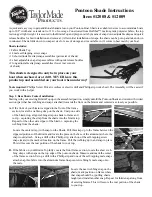
Operating lnstructions-5110
Fig.
1-5. Measuring time duration (period) between points on
a
waveform.
3. Adjust the vertical
Position control to
move
the
points between
which the time measurement is made to
the
center horizontal
line. Adjust the horizontal Position
control
to center the time-measurement points within the
center
eight divisions of the graticule.
4. Measure the
horizontal distance between the time
measurement
points. Be
sure the variable Seconds/Div
control
is in the Cal position.
5. Multiply
the distance measured in step 4 by the
setting
of the Seconds/Div switch.
EXAMPLE:
Assume
that the horizontal distance
between
the time-measurement points is
five
divisionsand
the
Seconds/Div switch
is set
to .1 ms. Using the formula:
2.
Take the reciprocal of the period to determine the
frequency.
EXAMPLE:
The frequency
of
the signal shown in Fig. 1-
5,
which
has a period of
0.5 millisecond is:
Frequency
=
—V-r =
73-=^-----
= 2 kilohertz
M
period 0.5 ms
1. Measure the period
of one
cycle of the waveform as
described in the
previous application.
Risetime
Measurement
Risetime
measurements
employ basically the same
techniques
as
the time-period
measurements. The main
difference is
the points between which the measurement is
made.
The
following
procedure gives the basic method of
measuring
risetime between
the 10% and 90% points of the
waveform.
1. Connect
the signal to the
input connector.
2.
Set
the
Volts/Div switch and variable Volts/Div
control
to
produce a display exactly five divisions in
amplitude.
3.
Center the
display about the center horizontal line
with
the
vertical
Position control.
4.
Set
the time-base triggering controls to obtain a
stable
display. Set the Seconds/Div switch to the fastest
sweep
rate that will display less
than eight divisions
between
the 10% and 90% points
on the waveform (see Fig.
1-6).
horizontal
Sec/Div
Period —
distance x
switch (5) (0.1
ms)
= 0.5 ms
(divisions)
setting
The period is
0.5
millisecond.
Determining
Frequency
The
time measurement technique can
also be used to
determine
the frequency
of a signal. The frequency of a
periodically
recurrent signal is the reciprocal of the time
duration (period)
of
one cycle. Use the following
procedure:
1-11
Summary of Contents for 5110
Page 6: ...5110 Fig 1 1 5110 Oscilloscope 2134 01 ...
Page 22: ......
Page 34: ......
Page 42: ......
Page 83: ...5110 I43XII3 2134 15 ...
Page 84: ... i 143 I132 2134 15 BLOCK DIAGRAM ...
Page 85: ... t 2 E I 5110 S LNHNOdWOD BOVJHaiNI ...
Page 88: ...J4 O3 INTERFACE J INTERFACE A NOV 1978 ...
Page 92: ...AUXILIARY BOARD 1143 2134 18 AUXILIARY BOARD ...
Page 95: ...DEFLECTION AMPLIFIERs ...
Page 102: ...LV POWERSUPPLY CALIB COMPONENTS A 4 L V Power Supply circuit board 5110 ...
Page 107: ...SIGNALS OUT OPTION 7 ONLY SI 10 OPT 7 213 26 REV A FE BI979 SIGNALS OUT COPTION T ONLY n ...
Page 114: ......
Page 115: ...5110 OSCILLOSCOPE ...
Page 116: ...FIG 2 MAINFRAME p 5110 OSCILLOSCOPE ...
Page 117: ...1 ...
Page 121: ...o ...
Page 122: ...S 1 5110 OSCILLOSCOPE ...
Page 123: ...13 FIG 4 RACKMOUNT CABINET 5110 OSCILLOSCOPE ...
Page 124: ......
















































